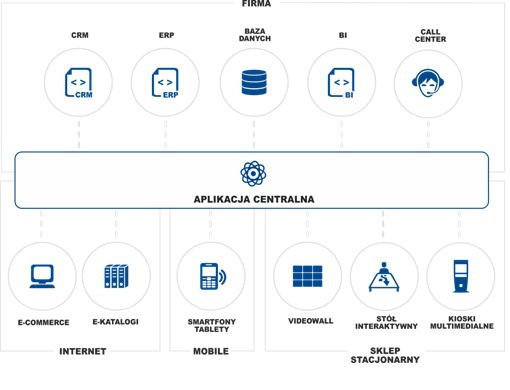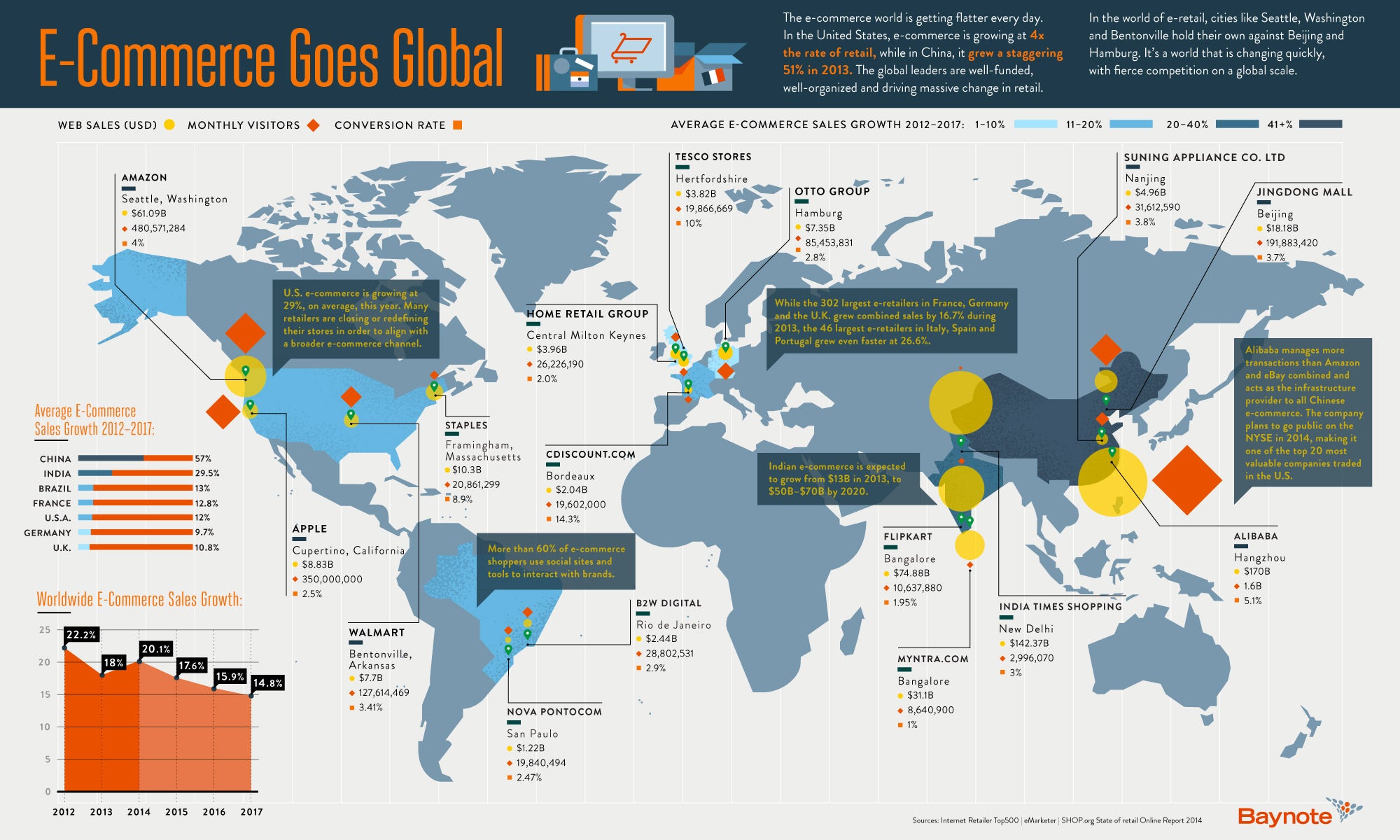Vietnam: ecommerce sales on the wave of consistent increase - report
Monday, 28th April 2014
According to this, Vietnamese online shopping has registered a considerable increase in 2013, with total revenues reaching USD 2.2 billion, or up by 314% by comparison with 2012.
"Online purchase average was USD 120 per capita in 2013."
"The significant growth rate of internet users, which has been triggered by the rapid development of the country’s ecommerce, has determined VECITA to revise its 2015 forecast for the sector from USD 1.3 billion to over USD 4 billion in revenue."
"The current internet-connected population surpasses the 30 million barrier, and about 40%-45% of the total population is forecasted to use the online channel by 2015. VECITA has foretold that every Vietnamese person will spend at least USD 150 on ecommerce purchases on a yearly basis."
"Still, with a population of 93 million projected for 2015, about 65% to 70% of the population with an internet connection will generate from USD 4.08 billion to USD 4.3 billion in online shopping revenue."
"The popular online products were clothes, shoes and cosmetics, making up 62%. The second most popular categories were technology products with 35% followed by household products with 32% and air tickets with 25%."
"Cash was a major payment method in online transactions with 74% of respondents opting for it and 41% transferred via banks. 11% used bank accounts, 9% resorted to mobile and game cards, and only 8% used electronic wallets."
How Does Web Page Speed Affect Conversions? - infographic
Friday, 25th April 2014
"Performance has only recently started to make headway into the conversion rate optimization (CRO) space. These inroads are long overdue, but still, it’s good to see movement. In the spirit of doing my part to hustle thing along, here’s a collection of infographics representing real-world examples of the huge impact of page speed on conversions."

Source Web Performance Today
Moda na wiele kanałów
Friday, 25th April 2014
Na portalu Ecommerceblog.pl pojawił się artykuł o wielu kanałach docierania do konsumenta.
"WspóÅ‚czesnego konsumenta, podążajÄ…cego za najnowszymi rynkowymi trendami, wcale nie trzeba uczyć, jak dotrzeć do informacji o interesujÄ…cych go produktach. Åšwiadomość szerokiego wachlarza możliwoÅ›ci kontaktu, niejako wymusza na sprzedawcy uruchamianie tych kanaÅ‚ów, z jakich chce korzystać klient."
"PodejÅ›cie do wielokanaÅ‚owoÅ›ci przeszÅ‚o dÅ‚ugÄ… drogÄ™ ewolucji w Å›wiadomoÅ›ci detalistów. W oczach przedsiÄ™biorcy salon stacjonarny, sklep internetowy, interaktywny kiosk czy aplikacja mobilna, nie sÄ… już traktowane jako caÅ‚kowicie odrÄ™bne kanaÅ‚y sprzedaży. Kluczem do sukcesu jest spójność wszystkich wykorzystywanych narzÄ™dzi i kanaÅ‚ów. BÅ‚Ä™dem natomiast traktowanie każdego z kanaÅ‚ów jako osobno dziaÅ‚ajÄ…cego bytu. Oczywistym jest, że każdy z nich rzÄ…dzi siÄ™ innymi prawami, ale kluczowa jest traktowanie ich jako jedność – wdrożenie wspólnej strategii sprzedażowej oraz marketingowej."
"Multichannel otwiera przed sprzedawcÄ… wiele możliwoÅ›ci na wyróżnienie, a także usprawnienie dziaÅ‚ania przedsiÄ™biorstwa. ZwÅ‚aszcza w przypadku dużych firm czy sieci handlowych, pojawia siÄ™ potrzeba integrowania poszczególnych kanaÅ‚ów oraz systemów ERP, CRM, baz danych wykorzystywanych w codziennej pracy. Im wiÄ™cej przybywa systemów, tym coraz wiÄ™kszego znaczenia nabiera, że systemy te powinny dziaÅ‚ać razem, a nawet być zarzÄ…dzane z poziomu jednej centralnej aplikacji. Takie rozwiÄ…zanie zapewnia pracÄ™ na jednej bazie klientów i zbieranie informacji z kilku miejsc jednoczeÅ›nie, o ich zachowaniach zakupowych oraz upodobaniach."
"Popularność strategii wielokanaÅ‚owych potwierdzajÄ… wyniki ostatnich badaÅ„, przeprowadzonych przez firmÄ™ doradczÄ… CBRE wÅ›ród 50. wiodÄ…cych detalistów na Å›wiecie. Dane opracowane na podstawie ankiet jednoznacznie wskazujÄ… na to, że miÄ™dzynarodowe sieci handlowe planujÄ… silny rozwój wielokanaÅ‚owy w 2014 roku i co wiÄ™cej, chcÄ… korzystać przy tym z zaawansowanych, nowych technologii. 80 proc. badanych wskazuje na to, że wielokanaÅ‚owe dziaÅ‚ania zwiÄ™kszÄ… ruch klientów w ich salonach. Z kolei aż 87 proc. twierdzi, że wielokanaÅ‚owość może wpÅ‚ynąć pozytywnie na wysokość ich caÅ‚kowitych dochodów. Natomiast 66% ankietowanych przyznaÅ‚o, że gÅ‚ównym celem ich strategii cyfrowej jest dążenie do wzrostu przychodów poprzez zwiÄ™kszenie liczby odwiedzin zarówno online, jak i offline."
ŹródÅ‚o Ecommerceblog.pl
Mix and match: the benefits of mixing fraud detection models
Thursday, 24th April 2014
Crossborder Ecommerce published the article about the benefits of mixing fraud detection models.
"Merchants looking at cross-border expansion, or those already trading overseas, need to think carefully about their choice of fraud detection model to support sales growth and manage risk in new markets. As with any other component of the fraud strategy, flexibility is important for establishing an effective solution."
"Broadly speaking, merchants tend to favour either a Pass/Fail strategy – where an order is instantly approved or rejected by an automated fraud screening engine – or a Manual Review approach – where suspicious transactions are held for a final decision to be made by an order verification team."

Source Crossborder-ecommerce.com
"The Pass/Fail approach can work very well for merchants experiencing low decline and chargeback rates and higher false positives. A Manual Review strategy, on the other hand, provides greater flexibility and potential to realise additional revenue, but increases demand on resources."
"A growing number of cross-border merchants are finding that a mix of fraud detection models can best meet their requirements. Here are two examples of a mixed model approach:
- Example 1:
A US retail merchant sells and ships fashion accessories in the US, Canada, Europe and China. The merchant has a domestic review team implementing a Manual Review fraud detection model for US and Canadian orders. Language barriers, limited verification tools and local market data, time zone differences and resource limitations all make this approach difficult and more costly for their overseas operations. As a result, the merchant operates a secondary Pass/Fail model for orders originating from Europe and China. This approach has enabled the merchant to successfully reduce the risk of fraud internationally while keeping the cost of manual reviews to a minimum.
- Example 2:
Another online merchant selling electronic products, including high cost items such as tablets, computers and cameras, has very few resources available to review orders manually. This merchant deploys a Pass/Fail model for all mid-to-low cost orders and a secondary Manual Review model for high value orders. This allows the merchant to review high risk but potentially profitable orders, while maximising mid-to-low value transactions."
"An inappropriate fraud detection model can be very damaging so it is important that each merchant selects the approach best suited to their individual business, and to their domestic and cross-border expansion plans. An experienced ecommerce risk analyst can help to provide guidance to merchants on how to implement an effective solution that manages risk exposure while meeting sales and customer service goals."
Where E-Commerce Is Booming. Hint: Think Outside the U.S. - Infographic
Wednesday, 23rd April 2014
"China and India are expected to see faster e-commerce sales growth over the next five years than any other country, according to this infographic compiled by Baynote, a firm that helps companies drive personalized shopping experiences across multiple e-commerce channels. That means bigger things for Alibaba -- the e-commerce behemoth of China that currently oversees more transactions than Amazon and eBay combined – and Flipkart, the e-commerce giant of India."
"Growth in e-commerce sales depends on a country’s prospering middle class, access to capital and the sophistication of the mobile to computer experience, Baynote's director of marketing Marti Tedesco said in a blog post."
"As e-commerce explodes, you are going to be left behind if you aren’t making your business ever more mobile friendly. The expansion of e-commerce "directly translates into goods and services bought such as smartphones and electronics," Tedesco says. "Savvy retailers have capitalized on this new wealth by investing in mobile sites and apps that make buying goods online simple and accessible for more people than ever before.”"
(Click to enlarge). Source Entrepreneur
More info here.
| Page: 68 / 103 | ||||
| Previous Page | 63 64 65 66 67 68 69 70 71 72 73 74 75 76 77 78 79 80 | Next Page | ||
Archive
- Latest
- May, 2024 (2)
- February, 2024 (1)
- November, 2023 (2)
- June, 2023 (1)
- January, 2023 (1)
- November, 2022 (1)
- August, 2022 (1)
- July, 2022 (1)
- May, 2022 (1)
- April, 2022 (1)
- March, 2022 (3)
- April, 2016 (1)
- February, 2016 (1)
- November, 2015 (2)
- September, 2015 (4)
- August, 2015 (4)
- July, 2015 (6)
- June, 2015 (8)
- May, 2015 (4)
- April, 2015 (1)
- March, 2015 (3)
- February, 2015 (1)
- December, 2014 (35)
- November, 2014 (33)
- October, 2014 (28)
- September, 2014 (20)
- August, 2014 (30)
- July, 2014 (46)
- June, 2014 (40)
- May, 2014 (50)
- April, 2014 (41)
- March, 2014 (23)
- February, 2014 (54)
- January, 2014 (37)
- May, 2013 (19)
- April, 2013 (8)

